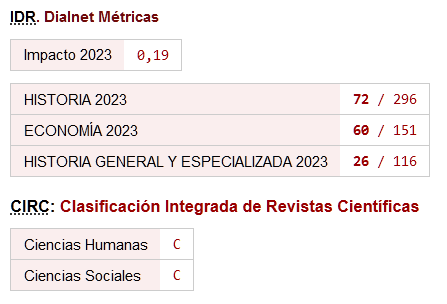The Bank of San Carlos
the broken principle of prudence after the departure in 1790 of Cabarrus and his management team
DOI:
https://doi.org/10.26784/issn.1886-1881.v10i18.66Keywords:
Accounting history of banking, Bank of Saint Charles, Activity, control and accounting prudence, 18th centuryAbstract
The Bank of San Carlos, was founded in 1782, and was set up to achieve three different objectives which have been considered strange to the researchers: the management of special kind of Public Debt called Vales Reales, the supply of military troops, and usual banking operations called Real Giro. Nevertheless, it existed not only for economical reasons for integrations of these activities in the institution.
The profits of the Bank exceeded all predictions in the first years when it was operative. Nevertheless, a series of troubled operations would determine a crisis of confidence in the management developed by the administrators. Previously, due to the lack of elements of effective control in the entity, the Bank established in 1788 a Commission of Shareholders, which was in charge of checking both the accounts and the moral of the directors. Its conclusions, one year later, would confirm the full integrity of the stockholder`s equity and the correct distributions of dividends. This Commission proposed to create a new group, called commissioners, who, like auditors, would annually verify the accounting statements.
In fact, one of the firsts actions of the commissioners, was to raise objections to certain items with Royal Treasury, motivated by the business of the supply of troops. The evaluation of the Bank situation made at this time showed a lack of stockholder`s equity, it was suggested to dedicate the profits of 1789 to cover it. After powerful reasons were given, the shareholders, agreed about not receiving any dividend, in order to dedicate it to the reconstitution of the shareholder`s capital, keeping the principle of prudence.
With the new directors in 1790, although the lack of stockholders' equity evaluation was increased, the principle of prudence was broken. The reasons that justified this decision made the previous year, were ignored and a dividend of 5 % was paid. This fact was supported by some expectations that already existed in the previous year which didn`t allow to reduce the uncertainty.
Three years later the King indemnified the Bank to cover such an imbalance. During this time the institution continued distributing dividends, persevering the way of having broken the principle of prudence previously established and in opposition to the good reputation of the Bank.
Downloads
References
Cabarrús Lalanne, F. (1782): Memoria que Don Francisco Cabarrús presentó a Su Magestad para la formación de un banco nacional por mano del Excelentísimo Señor Conde de Floridablanca en 22 de Octubre de 1781, Impreso por Joachin de Ibarra, Madrid.
Capella, M. y Matilla, A. (1957): Los Cinco Gremios mayores de Madrid, Imprenta Sáez, Madrid.
Conde de Mirabeau (1785): De la Banque d' Espagne dite de Saint Charles par le Comte de Mirabeau, Imprenta de don Pedro Marin, Madrid.
García López, A. (1999): Historia de la banca española a través de sus documentos, Lex Nova, Valladolid.
Hamilton Earl, J. (1970): "El Banco Nacional de San Carlos (1782-1829)", en El Banco de España. Una historia económica, Ferreira S.A., Artes Gráficas, Madrid.
Hernández Esteve, E. (1989): "Apuntes para una historia de la contabilidad bancaria en España", Revista Española de Financiación y Contabilidad, vol. XVIII, nº 58, pp. 21-96.
Hernández Esteve, E. (1993): "Noticia de la contabilidad del Banco Nacional de San Carlos en sus primeros tiempos (en torno a 1787). V Congreso de la Asociación de Historia Económica. San Sebastián, septiembre-octubre.
Hernández Franco, J. (1985): "Relaciones entre Cabarrús y Floridablanca durante la etapa de aquél como director del Banco (1792-1790)", en CHMC, VI-1985, pp. 81-91.
Lisbona y Fabrat, E. (1896): Los Bancos de Emisión de Europa. Sus leyes, organización, capital, operaciones, circulación fiduciaria y existencias metálicas, Establecimiento tipográfico de Ricardo Álvarez, Madrid.
Mayordomo García-Chicote, F. (2008): "Normas de control interno de la Dirección de Provisiones del Banco de San Carlos (1782-1789), en Actas del VI Encuentro de Trabajo sobre Historia de la Contabilidad, AECA y Universidad de Valladolid, Valladolid. https://doi.org/10.26784/issn.1886-1881.v6i11.132
Mayordomo García-Chicote, F. (2009): "Normas de control interno recogidas en el Reglamento de la Dirección del Giro del Banco de San Carlos (1789), De Computis, Revista Española de Historia de la Contabilidad (on line), número 11. https://doi.org/10.26784/issn.1886-1881.v6i11.132
Mayordomo García-Chicote, F. y Peyró Vilaplana, E. (2007): "La reglamentación del control interno del Banco de San Carlos entre 1782 y 1789: funciones de la Junta General, la Junta de Dirección y la Teneduría General de Libros", De Computis, Revista Española de Historia de la Contabilidad (on line), número 7. https://doi.org/10.26784/issn.1886-1881.v4i7.174
Moreno Fernández, R. (2010): El personal del Banco de España: desde su origen en el siglo XVIII hasta fin del siglo XIX. Banco de San Carlos, Banco de España, Estudios de Historia Económica 54, Madrid.
Ortega Costa, A, y Díez Tejerina, S. (1965): "Introducción al Conocimiento de Cabarrús", en BCNE 45, pp. 7-15.
Pérez Sarrión, G. (2008): "Intereses financieros y nacionalismo. La pugna entre mercaderes banqueros españoles y franceses en Madrid, 1766-1796″, en CHM Anejos VII, pp. 31-72.
Pulido Bueno, I. (1994): El Real Giro de España, Artes gráficas Andaluzas, Huelva.
Santillán, R. (1865): Memoria histórica sobre los Bancos desde el Nacional de San Carlos hasta el de España, tomo 1º, Establecimiento tipográfico de T. Fortanet, Madrid.
Tedde de Lorca, P. (1988): El Banco de San Carlos (1782-1829), Alianza Editorial, Madrid.
Zylberberg, M. (1993): Une si douce domination. Les milieux d'affaires français et l'Espagne vers 1780-1808. Comité pour l'histoire économique et financiere, Ministere de Finances. Paris.
Downloads
Published
How to Cite
Issue
Section
License

This work is licensed under a Creative Commons Attribution-NonCommercial-ShareAlike 4.0 International License.










